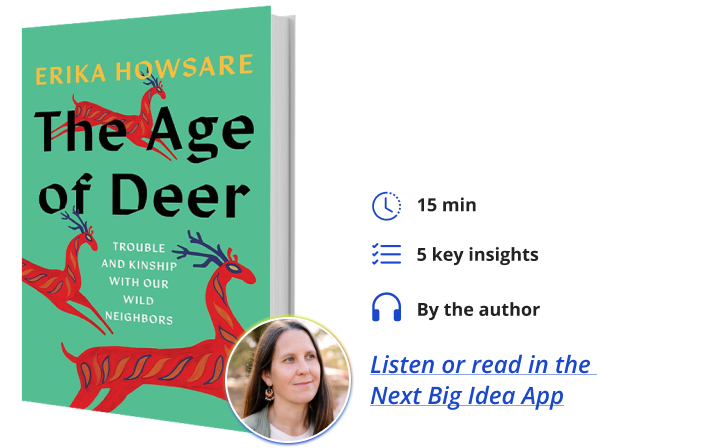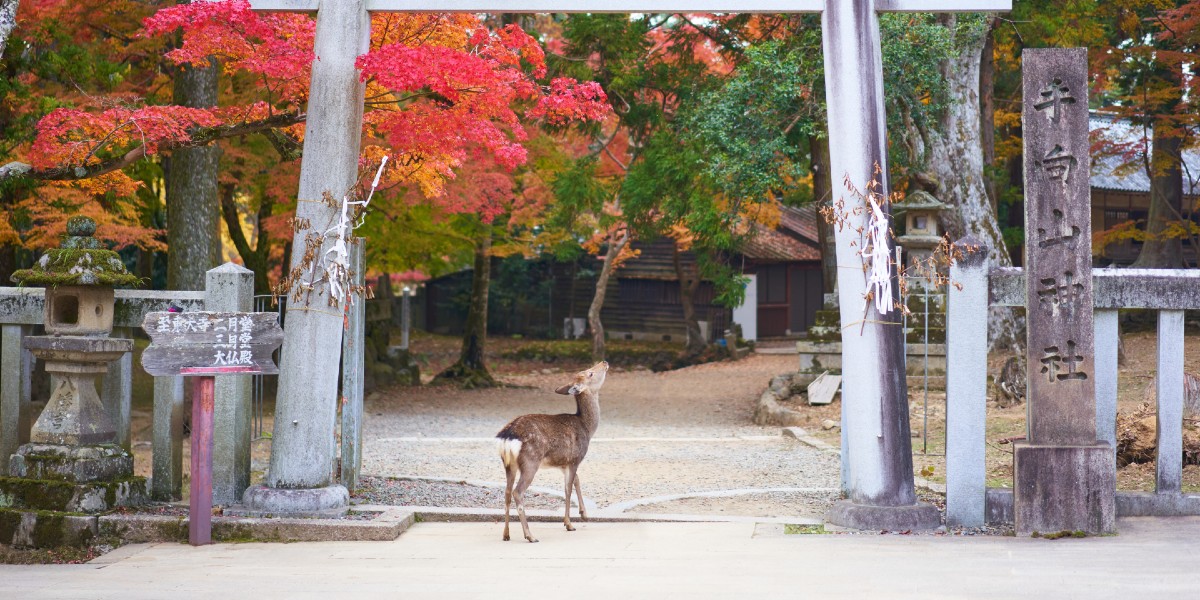Erika Howsare is a poet and nonfiction writer. Her work has been published in The Rumpus and LongReads, among other publications, and she works in local journalism in the Blue Ridge of central Virginia. She also teaches writing classes in her community.
Below, Erika shares 5 key insights from her new book, The Age of Deer: Trouble and Kinship with our Wild Neighbors. Listen to the audio version—read by Erika herself—in the Next Big Idea App.

1. Deer are everywhere in American history and culture.
Like many people, I see deer often. I live in a rural area, but even in suburbs and cities, deer are common. After being an essential part of human life for millennia, they continue to weave themselves into our daily lives. But what do we see when we look at deer? Why do we cast them in so many different roles, in all kinds of stories, from ancient myths to modern news articles? And what have we forgotten—what are we getting wrong—about deer?
The first Europeans who arrived in North America were accustomed to viewing deer as scarce and inaccessible. In Europe, by the Middle Ages, all deer had been considered the property of royalty, and only nobles had the right to hunt. Meanwhile, Indigenous people in North America relied heavily on deer for meat, hides, and other body parts—a deer could provide everything from food to tools to paint. Complex mythologies and practices developed to explain and protect this very important relationship.
When the two cultures met, a transatlantic trade in deerskins sprung up—the deer being killed by Native hunters and usually processed into buckskin (a fine, soft leather) by Native women. Especially in the Southeast, this trade accelerated colonization. It was a big industry: in a one-year period in the 1740s, for example, the Carolina colony exported around 150,000 deerskins to Europe. Southern cities like Charleston and Augusta centered their early economies on deerskins. The trade also changed life forever for Native Americans, bringing in European goods and shifting the relationship to the things deer could provide.
Buckskin became a symbol of the American frontier—think Daniel Boone in a fringed buckskin jacket—and still today, deer stand for many different things. I tracked news stories about deer and noticed some themes: deer are seen as pests, threatening drivers, and damaging gardens and crops. Deer are also victims that people love to save from dangerous predicaments, like when they fall into icy ponds or get stuck in fences, and they’re intruders who crash into houses, schools, and stores. I interviewed a security guard in North Carolina who had to tackle and remove a buck that crashed into the courthouse where he works.
But deer remain beloved icons, too. They show up constantly in graphic design, literature, and art. Bambi—a film released more than 80 years ago—still heavily influences how we think about both wildlife and hunters.
2. Deer were once wiped out from much of the U.S.
Overhunting for the deerskin trade, and by settlers, took a severe toll on the deer population. The settlers carried a delusional belief that the resources of this continent were more or less infinite. One hunter in 1845 killed 99 deer in 60 days, and at the time, that was legal. Many hunters were professional killers, supplying venison to an eager public. Americans also made sweeping changes to deer habitat by cutting down forests, creating farms, and removing predators. It’s hard to imagine now, but entire states became empty of deer by around the turn of the 20th century—picture Vermont, Ohio, or Kansas with no deer at all.
“It’s interesting to realize how closely conservation was intertwined with hunting from the start.”
The absence of deer helped spur the conservation movement, led by hunters who didn’t want their sport to die out—famously, Teddy Roosevelt and a bunch of his friends. They formed a conservationist group, named it the Boone & Crockett Club after two buckskin-wearing frontiersmen, and looked for ways to bring back deer and other game animals. It worked. They put the states in charge of regulating hunting, outlawed commercial hunting, and established wildlife preserves and national parks. It’s interesting to realize how closely conservation was intertwined with hunting from the start—even Yellowstone, our first national park, allowed hunting for the first decade it existed.
Another pillar of their work was to restock whitetail deer in at least thirty states. Deer were baited into traps (large wooden boxes with doors that suddenly slid downward, guillotine-style) and then opened into crates or nets. Then the deer would be loaded on trucks and hauled away, sometimes many hundreds of miles, from Wisconsin to Mississippi, or from Maine to Pennsylvania. Any whitetail you see today has a great chance of being descended from deer that were deliberately moved around by conservationists decades ago. That fact permanently changed how I see deer: a native animal, but the word “natural” no longer applies in quite the same way.
3. Deer like edges.
We often picture deer as wilderness creatures, a symbol of deep, quiet forests. However, though they can live in forests, they prefer to live in edge habitats. These ecotones might occur naturally when a forest meets a meadow or when young trees are growing back after a wildfire. Native Americans practiced controlled burning, partly because it made good habitat for deer and partly because the fire itself was a hunting method. In the modern world, we have created edges everywhere, like roadsides, powerlines, and pipelines. The suburbs are full of edges, where patches of woods meet lawns or parks. These are the places where the most deer food grows and where deer can most easily find cover.
This explains why deer can thrive so well among humans when they’re not overhunted. They’re unusual among large mammals in this way; historically, as humans have spread over the globe, megafauna have disappeared. Whitetail deer, especially (the most numerous species in the U.S.), are masters of adaptation. They can live in all kinds of habitats, including those heavily altered by human activity. I’ve spotted them behind shopping centers, in major cities, and on farmland. I once traveled to Oklahoma to try spotting mule deer, and after hiking all day through a remote state park, I finally spotted two mule deer hanging out between a house and a mailbox.
By fashioning the world to our own purposes, humans have inadvertently created a nirvana for deer. In many places, we’ve removed predators like wolves and mountain lions, too. This has left us in the position of struggling to control their numbers through hunting and professional culling.
4. We might be facing a decline of deer.
Though there are many places in the U.S. where deer are considered overpopulated, overall, their numbers have gone down by about a fifth since the turn of the millennium. They’re finding it harder to live in deep forests and becoming, on balance, a more urban species.
There’s also a disease called Chronic Wasting Disease, which first emerged in the 1960s and has since spread to more than half of the U.S. It’s a neurological illness that is always fatal and has no treatment or cure; it’s the deer equivalent of mad cow disease, caused by a misfolded protein called a prion.
“It’s a neurological illness that is always fatal and has no treatment or cure.”
I rode along with a group of scientists studying Chronic Wasting Disease (CWD) in newborn fawns. Their mission that night was to find fawns, put radio collars on them, and give them a brief checkup. One fawn was about two hours old, and the scientists told me that in that period of time, the baby may have already contracted CWD through her mother’s saliva. If so, she would probably not live past the age of two.
The prions that cause CWD can persist in the environment for years, waiting in the soil to infect more animals. Every year, CWD turns up in more locations, and authorities try to contain it, although there’s no effective way. CWD has the potential to author yet another dramatic chapter in the ecological story of deer, and their relatives, including elk and moose.
5. Deer are our kin.
Underlying all these shifts in population numbers, and beneath the millennia-old literary and artistic fascination that humans have for deer, is something very deep: a biological kinship that we, as mammals, share with deer. I’ve often been struck by how similar in size we are and, when watching hunters field-dress deer, how closely their bodies correspond to ours. There are many tales and stories from around the world in which humans and deer shapeshift into each other.
In our culture, we’ve spent centuries looking at animals as objects: to use, to protect, to study, but not as fellow travelers, fellow inhabitants of the earth with their own intelligence. Writing this book taught me to think of deer as a nation that exists alongside us and is far older than we are. Many Indigenous stories posit this idea that deer and humans have an ancient agreement in which deer provide meat and materials that the people need to survive.
Of course, that agreement entails humans hunting deer. These days, deer are the most popular animal to hunt in the U.S., which means they carry much of the meaning of how we currently practice one of the very oldest human activities. I found that deer hunting is a very large and diverse world. Some hunters look at deer as trophy objects and even raise deer with grotesquely oversized antlers on game farms.
But others see hunting as a complex engagement with questions of life and death—questions that seem to come up constantly in all aspects of our relationship with these animals. For some people, hunting is a way to ask what it means to be human—a way to tap into that very kinship we share with deer.
To listen to the audio version read by author Erika Howsare, download the Next Big Idea App today:































